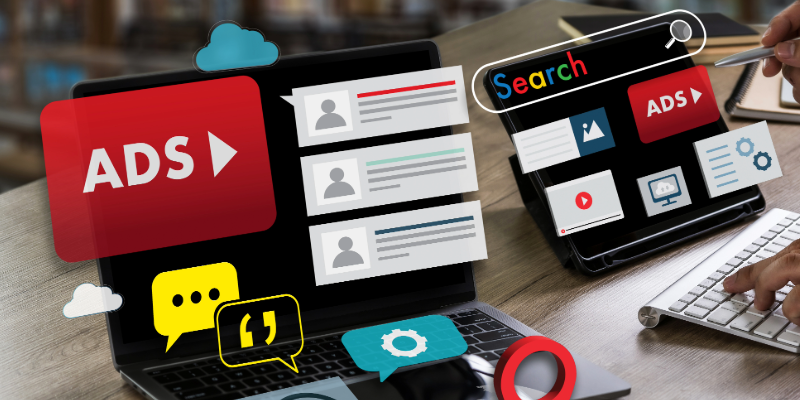Introduction
Digital advertising is more than just placing ads online; it’s a sophisticated strategy where businesses promote their offerings through various online platforms. Unlike traditional advertising, digital advertising leverages the internet to reach consumers through text, images, audio, and video formats. The flexibility of digital advertising allows for quick adjustments and optimizations during campaigns, making it a dynamic and adaptive marketing approach.
What sets digital advertising apart is its precision. Unlike traditional methods, digital advertising can target specific audiences with remarkable accuracy, ensuring that your promotional content reaches those most likely to be interested in your products or services. As more people spend time online, digital advertising becomes essential for connecting with audiences effectively. This shift from traditional to digital marketing underscores the importance of a strong digital presence for businesses of all sizes.
So, what exactly will you gain from delving into digital advertising? You’ll discover the different formats it encompasses, the benefits it offers over traditional advertising, and how it can be tailored to meet your specific marketing goals. Let’s dive deeper into what digital advertising entails and why it’s become a cornerstone of modern marketing strategies.

What Is Digital Advertising?
Digital advertising, also known as online advertising, is a powerful marketing method for promoting brands and products via online platforms. Digital advertising refers to its versatility as one of its greatest strengths, allowing businesses to create ads in various formats, including text, images, audio advertising, mobile advertising, and video, to cater to different business objectives and audience preferences. Unlike traditional advertising, digital ads can be deployed rapidly, going live almost immediately after creation, which is crucial for time-sensitive campaigns.
One of the key advantages of digital advertising is its targeted approach. Advertisers can reach specific audiences based on their interests, behaviors, and demographics. This means your particular ad can appear in contexts that are most relevant to your audience—whether they are browsing a web page, streaming media, or engaging with social media through interest based advertising, including a growing number of internet users, through online ads. Digital advertising important is evident in how effectively it connects brands with their desired customers.
Insights. Ideas. In Your Inbox
Different types of digital advertising include search advertising, search ads, display ads, video ads, social media ads, and audio ads, each serving unique purposes within your overall digital advertising strategy.
The ability to track and measure the performance of these ads in real-time allows marketers to optimize their campaigns continuously. Utilizing various digital channels and ad channels ensures your marketing efforts are both effective and efficient on mobile devices, ultimately driving better results for your business.
Now that you have a grasp on what digital advertising entails, let’s explore why it’s so crucial in today’s marketing landscape.
Why Digital Advertising Matters
Digital advertising offers several key advantages:
- It is a gateway to a global audience, breaking down geographical barriers that once limited traditional marketing.
- It is cost-effective, often providing a better return on investment compared to traditional methods.
- It allows precise measurement of campaign performance, enabling businesses to track engagement and ROI.
These benefits make it easier to justify ad spend and make informed decisions.
One of the standout features of digital advertising is its precision in audience targeting. Through digital platforms, marketers can tailor campaigns to specific demographics, interests, and behaviors, ensuring that their messages resonate with the right audience. This targeted approach enhances customer engagement and fosters two-way communication, allowing brands to interact directly with their customers and gather valuable feedback.
The flexibility of digital advertising is unmatched. Campaigns can be adjusted quickly based on real-time data and results, allowing marketers to optimize their strategies on the fly. This adaptability leads to improved conversion rates and a higher likelihood of achieving marketing goals. Additionally, the social currency generated through digital content can significantly boost brand visibility and relevance among consumers. With these benefits in mind, it’s clear why digital advertising is an essential component of any modern marketing strategy.
Types of Digital Advertising Channels
Digital advertising encompasses various channels, each leveraging the internet to reach consumers effectively. These channels include:
- Search engines
- Social media
- Display networks
- Video platforms
- Native advertising spaces Each channel has its unique strengths and can be tailored to meet specific marketing objectives.
Understanding the nuances of each major type of digital advertising channel will help you decide which ones are best suited for your ad campaigns and how to utilize them effectively to achieve your marketing goals.
Search Engine Marketing (SEM)
Search Engine Marketing (SEM) is a form of online advertising that helps businesses promote their products through paid search advertisements on search engine results pages. SEM focuses on paid advertising to enhance a website’s visibility on search engines like Google. One of the most significant advantages of SEM is that advertisers only pay per click when users click on their ads, making it a cost-effective strategy for driving traffic to their websites.
Effective SEM requires thorough keyword research to identify terms that potential customers are searching for. Strategically placing search ads at the top or side of the search results page maximizes visibility and quickly reaches a broader audience.
The main ad networks for SEM include Google Ads and Bing Ads, with Google Ads being the largest in scale. This approach allows businesses to generate traffic rapidly and effectively, making SEM one of the most powerful tools in digital marketing.

Social Media Advertising
Social media advertising leverages platforms like Facebook, Instagram, TikTok, and LinkedIn to deliver paid advertisements aimed at specific target audiences. This form of advertising allows businesses to target specific demographics based on user behavior and interests, making it highly effective in reaching the right audience. Social media ads can take various formats, including image ads, video ads, and sponsored posts, designed to engage users and promote brand awareness.
One of the key benefits of social media advertising is its cost-effectiveness, making it accessible for businesses of all sizes. Platforms like TikTok and Instagram have proven particularly effective in engaging younger audiences due to their visual nature and content formats.
Monitoring the performance of social media ads in real-time allows for strategy adjustments based on engagement metrics, achieving immediate visibility.
Display Advertising
Display advertising uses visual banner ads or graphics on web pages to capture the attention of potential customers. These ads typically:
-
- Appear as banners, images, or videos on web pages
- Aim to attract users’ attention and drive traffic to landing pages
- Integrate text, visuals, and a call to action, making them a versatile tool for online marketing, including text based ads and print advertising. Additionally, they effectively advertise products and services.
The effectiveness of display advertising lies in its ability to combine creativity with measurable marketing metrics, such as click-through rates and conversion rates. Display ads can be targeted based on user behavior and demographics, enhancing their effectiveness in reaching the desired audience. Additionally, programmatic buying can optimize ad placements across various platforms, making the process more efficient.
Video Advertising
Video advertising is a dynamic format that engages users through short video clips, often integrated within streaming platforms or social media. This format can include pre-roll, mid-roll, or post-roll ads that play before, during, or after video content, capturing viewer attention at different times. Video ads are highly engaging, combining visuals and audio to create compelling narratives that are more memorable than static ads.
Short-form video ads, typically under one minute, are particularly effective on social media platforms where audiences prefer quick content. Interactive elements in video ads encourage viewer participation, which can heighten engagement and retention rates compared to traditional video formats.
Whether on YouTube or social media, video advertising can significantly boost engagement and brand awareness.

Native Advertising
Native advertising blends seamlessly into the content of the platform, making ads less intrusive and more engaging for users. This type of advertising integrates promotional content within the look and feel of the surrounding media, reducing ad fatigue and enhancing user experience. Native ads often appear as recommended content or within social media feeds, creating a more seamless user experience.
Studies show that native ads are viewed 53% more often than traditional display ads, significantly increasing engagement. Programmatic native advertising automates the ad buying process, allowing advertisers to optimize their ad copy in real-time. By carefully considering elements like headlines and images, businesses can ensure their native ads align with the overall message and resonate with their target audience.
Setting Up Your First Digital Ad Campaign
Setting up your first digital ad campaign can be an exhilarating experience when done correctly. The key steps include:
- Align your key performance indicators (KPIs) with broader business objectives to ensure your campaign is optimized for success.
- Utilize first-party data, which is increasingly important due to restrictions on tracking and the deprecation of cookies.
- Refine audience targeting based on demographic factors.
Key strategies for improving digital advertising performance include:
- Regular testing of creative content and messaging to keep advertisements relevant and engaging.
- Optimizing landing pages to ensure they resonate with ad messaging, significantly improving conversion rates.
- Consolidating ad accounts to allow for better data analysis and improve overall campaign performance.
Employing a multichannel strategy facilitates targeting potential customers at various stages of the buying process. Focusing on high-performing campaigns and reallocating budgets maximizes returns and creates a robust digital advertising strategy that drives results through email marketing.
With these steps, setting up your first digital ad campaign can be a rewarding venture that paves the way for future marketing success.
Measuring Success in Digital Advertising
Measuring the success of your digital advertising efforts is crucial to understanding their impact and optimizing future campaigns. Key performance indicators (KPIs) are essential for evaluating the effectiveness of your marketing strategies in digital advertising. Tracking impressions helps measure brand visibility, indicating how many times ads were displayed to users.
The click-through rate (CTR) serves as a crucial metric for assessing the success of ad campaigns by measuring user engagement, including website visitors. Conversion rate reflects the percentage of visitors who complete desired actions, highlighting the effectiveness of your advertising strategy.
Customer acquisition cost (CAC) measures the total expense incurred to gain a new customer, providing insights into financial efficiency. Return on investment (ROI) calculates the profitability of your marketing efforts, helping you assess overall campaign performance.
Regularly monitoring these metrics provides valuable insights into campaign performance, allowing for data-driven decisions and optimized digital advertising strategies using Google Analytics.
Common Mistakes to Avoid
Even seasoned marketers can fall into common pitfalls when it comes to digital advertising. Failing to establish clear, realistic goals can lead to an unfocused marketing campaign, making it difficult to measure success. Targeting an overly broad audience often results in irrelevant content reaching uninterested individuals, wasting valuable resources.
Ignoring search engine optimization (SEO) can limit your business’s visibility on search engines, resulting in lost traffic. Additionally, neglecting to utilize social media can lead to missed opportunities for engagement and building brand loyalty.
Awareness of these common mistakes helps avoid them and create more effective digital advertising campaigns.
Final Thoughts: Getting Started with Confidence
Embarking on your digital advertising journey can be daunting, but with the right knowledge and tools, you can start with confidence. Understanding the fundamentals of digital marketing is crucial before launching any campaigns. Selecting the right digital marketing channels is essential, as different platforms serve diverse audience demographics.
Acquiring core skills such as:
- SEO
- Copywriting
- Social media management is vital for effective digital marketing. Staying updated on digital marketing trends is essential for maintaining a competitive edge in a fast-evolving landscape.
Building a strong foundation and continuously learning will help you navigate the digital advertising world with assurance and achieve your marketing goals.
Summary
In summary, digital advertising offers a dynamic and flexible approach to reaching your target audience through various online channels. From understanding what digital advertising is and why it matters, to exploring different advertising channels and setting up your first campaign, this guide has equipped you with the knowledge needed to succeed.
Remember, the key to effective digital advertising lies in continuous learning and optimization. By measuring your campaigns’ success and avoiding common mistakes, you can refine your strategies and achieve better results. Embrace the power of digital advertising and take your marketing efforts to new heights.
Frequently Asked Questions
What is digital advertising?
Digital advertising is the promotion of brands and products through online platforms using various formats like text, images, audio, and video. It enables precise audience targeting and allows for real-time performance tracking.
How does digital advertising differ from traditional advertising?
Digital advertising differs from traditional advertising by enabling quick deployment, immediate visibility, and precise audience targeting, while also providing superior measurement capabilities for tracking engagement and return on investment. This agility and precision make it a more effective choice for marketers today.
What are some common types of digital advertising channels?
Some common types of digital advertising channels are search engine marketing (SEM), social media advertising, display advertising, video advertising, and native advertising. These channels provide unique advantages that can be aligned with your specific marketing goals.
How can I measure the success of my digital advertising campaign?
To measure the success of your digital advertising campaign, focus on key performance indicators (KPIs) like impressions, click-through rate (CTR), conversion rate, customer acquisition cost (CAC), and return on investment (ROI). These metrics will provide valuable insights into your campaign’s effectiveness and guide your optimization efforts.
What are some common mistakes to avoid in digital advertising?
To create effective digital advertising campaigns, avoid common mistakes like failing to set clear goals, targeting too broadly, neglecting SEO and social media, and ignoring remarketing to existing leads. By steering clear of these pitfalls, you’ll enhance your campaign efficiency and effectiveness.


